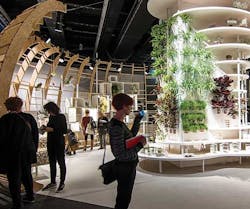In Heimtextil’s design universe, all trends orbit and grow toward the sun.
The fair’s colossal trend exhibit is set up as a “Theme Park,” and is possibly the world’s largest. It’s certainly the first destination for the international design community each year, kicking off a barrage of early exhibitions that include the Koeln furniture fair (IMM), the Domotex flooring show in Hannover, and Maison & Objet in Paris.
The design vision for 2016’s Theme Park was generated in part by Lisa White and Helen Sac of the WGSN Group, backed up by the fair’s Trend Table of design agencies from six countries.
This year’s theme, “Wellbeing 4.0,” brings together four trends and interprets them for our different markets: Hospitality (Timeless Refuge), Technology (Color Immersion), Craft (Craftsmanship in the Post Digital Age), Retail (Intimate Retail), and Sustainability (Elemental Harmony).
Each market is represented by a raw plywood “cocoon” structure, which orbits a center “sun”—a large round pedestal illuminated with color-shifting LEDs, rimmed with large “petals” pointing toward and carrying the palettes of each of the five cocoons.
The four trends (hence Wellbeing 4.0):
- Protect: Colors reflecting the idea of purity, lightness, and silence, whether found in daylight or at night.
- Energize: Colors pulsating with high and low contrasts. Intense and almost fluorescent shades vibrate against deeper electric blue hues.
- Nourish: An emphasis on greenery with colors that celebrate the beauty of a green hue and its environmental elements—earth, stone, deep browns, and grays.
- Enrich: Generous, deep colors like plum and carmine red flourish, with metallic accents of gold, brass, and gunmetal.
“How do we ‘spot’ trends? There is no school for trend forecasting; it’s a matter of training your eye,” said Lisa White, head of WGSN Lifestyle & Interiors. “It’s less about predicting the future than it is being able to see the future in the present.
“When you go shopping something will catch your eye, like the color of a shirt. That’s what we look for, but we’ve trained ourselves to see things that will look new to someone else 18 months in advance. If something looks good to me, I can pretty much tell you when it’s going to hit certain markets.
“Color is more important in interiors than it is in fashion,” continued White. “Your wall and furniture affect your mood and wellbeing, and you can’t change those as often or as easily as you can change clothes.
“Commercial spaces tend to be a little more conservative, less fantasy. Those designers are some of the most forward-thinking people ever, but there are so many restrictions—‘Is it safe? Will it last?’—they have to please the most people,” said White.
In retail, there’s a trend toward tactility and temptation of touch, she added. “Materials play a big role in getting us away from the screen. We’re really getting tired of slick surfaces; our fingers are hungry for tactility. We used a lot of plywood in the Theme Park. It’s so refreshing to be in contact with something like that!”
“Once you start thinking about forecasting trends, you can’t turn it off,” said Helen Sac, senior consultant with WGSN Mindset. “I’ll walk into a space and I’ll see eight people wearing black and think about why they’re doing that. Why were people wearing black 10 years ago and what did it mean then. What’s happing in the world that makes it okay. What about in 10 years?
“With wellbeing, for example, if it’s in your mind you’re going to be subconsciously searching out things that make you feel calm, then you know designers’ work will be taking on this mood as well.
“Take fitness,” Sac continued. “You wouldn’t think it would actually affect interiors or fashion, but more and more people are wearing sneakers and gym clothes everywhere but they’re more stylized. This really does trickle down and affect the market. Things are getting cozier, more comfortable, nicer to wear. Everything stretches now, even jeans. People want to be comfortable. This is one way to interpret ‘wellness.’”
About the Author

Kenn Busch
Contributing Editor
Kenn Busch is a longtime journalist, educator and public speaker dedicated to bridging the knowledge gap between materials, sustainability, and furniture and interior architecture. He is the founder of MateralIntelligence.com and ClimatePositiveNOW.org, two major resources for design and manufacturer specifiers.
